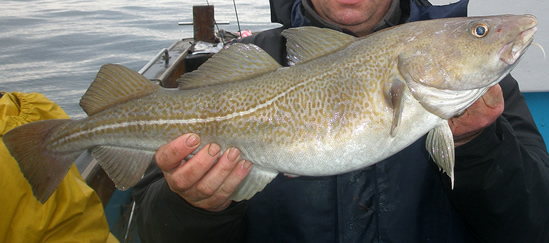The Atlantic cod has historically been one of the world’s important natural resources, and the waters of the North Atlantic once teemed with this fish. Today, the commercial catch of cod is far below historic levels, and cod are generally in a collapsed or near-collapsed condition.
Identification
The Atlantic cod has three dark dorsal fins and two dark anal fins, none of which contain any spines. The body is heavy and tapered, with a prominent chin barbel, a large mouth, and many small teeth. Its snout is rounded on top, and the tail is almost squared. There is a characteristic pale lateral line. The coloring is highly variable on the back and the sides (ranging from brownish or sandy to gray, yellow, reddish, greenish, or any combination of these colors), gray-white on the underside, and with numerous light spots covering the body.
Size/Age
Young fish ages 2 to 5 generally constitute the bulk of the cod catch, with the average size being from 4 to 15 pounds. Larger sizes in New England are not unusual, some with a length of 30 to 40 inches. When they were more abundant, cod were caught in the 55- to 75-pound range and have been known to reach 211 pounds. The all-tackle fishing record is 98 pounds, 12 ounces. Atlantic cod can live up to 22 years.
Spawning behavior
The spawning season is during December and January off the Mid-Atlantic Bight and from February through April farther north.
Food and feeding habits
Omnivorous feeders, cod are primarily active at dawn and dusk. Their primary diet is invertebrates and assorted fish. Very young cod feed on copepods and other small crustaceans while at the surface and, after dropping to the bottom, on small worms or shrimp.
Other Names
cod, codfish, codling, scrod; French: morue de l’Atlantique; German: dorsch, kabeljau; Italian: merluzzo bianco; Japanese: madara, tara; Norwegian: torsk; Portuguese: bacalhau; Spanish: bacalao del Atlántique.
 |
| Atlantic Cod |
Distribution
Atlantic cod occur in subarctic and cool temperate waters of the North Atlantic from Greenland to North Carolina. They have generally been most abundant in the Gulf of St. Lawrence, off New-foundland. In U.S. waters, cod are assessed as two stocks, the first being that of the Gulf of Maine, and the second being that of Georges Bank and south-ward.
Habitat
These fish are found primarily off the coasts along the continental shelf. They prefer cool water of 30° to 50°F and may reside in depths of up to 200 fathoms. Adults are generally found in water over 60 feet deep, whereas juveniles may be found in shallower water; both move deeper during the summer.



